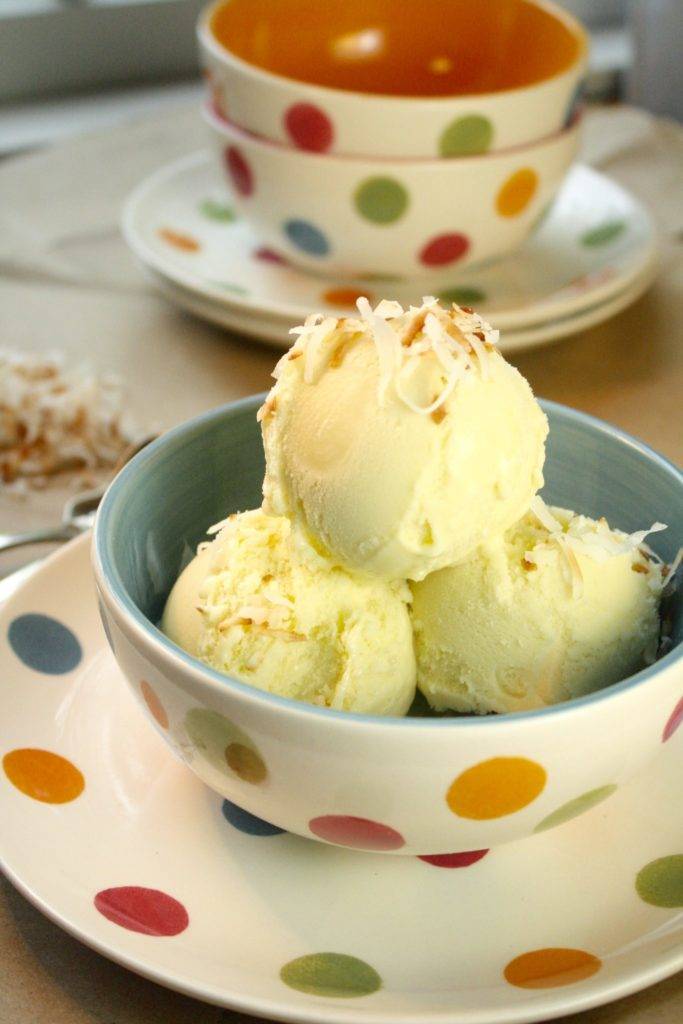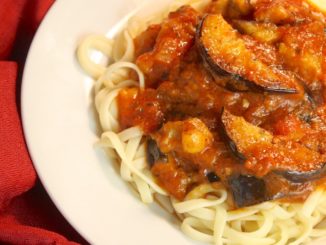Summer lovin’ had me a blast. Like this Coconut Ice Cream.
Summer lovin’ happened so fast. Seriously, this coconut ice cream can be chillin’ in your freezer in about an hour. I kid you not.
Tell me more…Tell me more…
Remember the movie Grease? Adult actors playing 1950’s high school kids all spun up over the Good Danny/Bad Danny-Good Sandy/Bad Sandy romance? The one with spontaneous singin’ and dancin’, poodle skirts, leather jackets, and saddle shoes? I love that movie in all it’s completely unrealistic and oddly misogynistic glory. (Seriously, why did Sandy have to morph into a skintight leather hot pants-wearing cigarette smoking ‘bad’ girl to get the guy? If you’re reading this girls, tweens, teens, and grown women – It’s just a movie. DON’T DO IT! You are awesome and wonderful and worthy as you are.)
But, seriously, the soundtrack! I mean! One note of Summer Lovin’ or Hopelessly Devoted and I’m 12 again, spending the summer running wild and watching that movie every single time HBO aired it. Every. Single. Time. That movie IS summer to me and I can’t get enough of it or this Coconut Ice Cream.
Coconut Ice Cream
You’ll be Summer Lovin’ it, too, especially now that somebody’s turned the thermostat from I-Am-So-Glad-It’s-Not-January to October-Where-You-Hiding?
Homemade ice cream is not nearly as impossible to make as you might think. It’s all about the custard. Custard, by definition, is a mix of milk, heavy cream or a mix of both, and egg yolks. We flavor that custard with sugar, extracts, or whatever your tastebuds fancy then churn it away in an ice cream maker until it’s thick and creamy, the stuff that sweet dreams are made of.
For vanilla ice cream, use heavy cream instead of coconut milk and vanilla extract in lieu of coconut extract. It’ll be delicious but the coconut flavor is fantastic and it makes me feel like I’m on a tropical vacation, which I’m ALWAYS down for.
The trick to making great ice cream at home is to mind your custard. For most ice cream recipes, heat your heavy cream/milk/coconut milk and a little sugar to a simmer, whisk your egg yolks with a little sugar until the sugar begins to dissolve and the yolks are pale yellow and slightly thick. Combining these two is where you’ll want to pay attention.
The heavy cream/milk/coconut milk mixture will be hot. Your yolk/sugar mixture will not be and one thing we know about eggs is they don’t require a lot of heat to cook them. If you dump your hot milks into your egg yolks all willly-nilly you’ll end up with a scrambled egg custard. Un-unh. Nope. Even if you strain out the tiny bits of cooked egg yolk your custard will STILL taste like a sweet omelet. Don’t do it. Start over.
Or avoid that literal hot mess to begin with. Your skill as a culinary genius will shine bright when you TEMPER these two sets of ingredients together into a creamy, smooth example of what all custards should be. You can do it.
Tempering
Tempering is a method of combining two ingredients when one ingredient is fragile. In this case, our egg yolks are playing the role of fragile flower to the big, bad hot cream. Here’s how you get it done.
Use a ladle or small measuring cup to add a splash of the hot dairy into the yolks while you’re simultaneously whisking the yolks like there’s no tomorrow. Here’s why. If you keep the yolks moving fast enough when you add in the hot stuff, the mixture won’t sit still long enough for the heat from the milk/cream to warm the yolks to a dangerous temperature. You’ll gradually raise the temperature of the yolks so it’s not such a shock when you start to add in the rest of the hot milk/cream. Make sense?
Once you’ve tempered to perfection and your hot milk/cream and yolks are all BFFs in the bowl, pour the custard (yes, it’s now a custard) back into the pot you heated the milk/cream in and get it back on a medium-low heat. The goal now is to gently cook the custard so you’re not eating raw egg yolks. As the custard cooks, it’ll thicken and once it’s thick enough to coat the back of a wooden spoon it’s ready to strain and chill.
Strain your custard into a bowl that’s set into a larger bowl filled with ice. This will help cool it down fast so you can get it into the fridge or ice cream maker in a jiffy. Some recipes suggest you cool the custard to room temperature then let it hang out in the fridge for a couple of hours so it’s nice and cold when you put it in the ice maker. I get great results by getting it down to room temperature then adding it directly to my ice cream maker.
You can absolutely make this without an ice cream maker. Pop it in your freezer in an airtight container and it’ll firm up. It won’t be creamy – the ice cream maker churns air into the custard, which is what makes it creamy. (If you have an energetic kid, give this cool Ball Ice Cream Maker a try.) I like to garnish my Coconut Ice Cream with toasted coconut but it’s whomp-bomb-a-lol-bop-a-whop-bam-boom all on its own.
Give this Coconut Ice Cream a try. Share it with your favorite Pink Ladies and T-Birds and it’ll be gone in a flash.
Summer dreams ripped at the seams, but, oh…that Coconut Ice Cream.
TIPS:
Be careful not to scramble your egg yolks when you add the hot milk/cream. Temper them together to avoid a sweet omelet custard.
Cool your custard to room temperature before adding it to your ice cream maker. Hot custard will heat up your ice cream maker’s bowl before it’s done its job.
Be sure to use coconut milk NOT coconut cream. Coconut cream has added sugar.
TOOLS:
Medium Pot
The tools section may contain affiliate links to products we know and love.
TECHNIQUES:
Simmering
Ingredients
- 5 large egg yolks
- 1/4 cup sugar
- 1 14-oz can coconut milk (1 3/4 cup)
- 3/4 cup whole milk
- 1/4 cup sugar
- Pinch of coarse kosher salt
- 1 teaspoon coconut extract
- Toasted Coconut, optional
Instructions
- Whisk egg yolks and 1/4 cup sugar together in a medium bowl until pale yellow and thin, about a minute.
- Combine coconut milk, whole milk, 1/4 cup sugar and salt in a medium pot. Heat just to a simmer, remove from heat and stir in coconut extract.
- Add a splash (about 1/2 cup) of the warm milk mixture into the egg yolks, whisking constantly. Gradually whisk in the remaining warm milk mixture then pour it back into the pot. Cook over medium low heat, stirring constantly, until custard thickens enough to coat the back of a wooden spoon, 2-3 minutes.
- Strain custard into a medium bowl set over a bowl of ice. Let custard cool to room temperature then process in an ice cream maker, according to manufacturer's instructions, until thick and creamy. Transfer to an airtight container. Cover and freeze until firm, at least 4 hours.










1 Trackback / Pingback